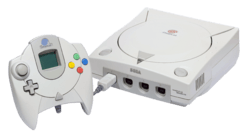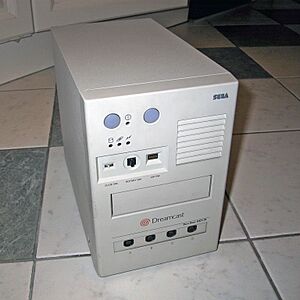Sega Dreamcast facts for kids
| Manufacturer | Sega |
|---|---|
| Type | Video game console |
| Generation | Sixth generation era |
| Units sold | 10.6 million |
| Media | 1.2 GB GD-ROM |
| CPU | 200 MHz Hitachi SH4 RISC |
| Storage | VMU, Nexus Memory Card |
| Online services | SegaNet Dreamarena |
| Best-selling game | Sonic Adventure |
| Predecessor | Sega Saturn |
The Sega Dreamcast (called ドリームキャスト in Japanese) was a home video game console. It was the fourth and last console made by Sega. The Dreamcast came out before other popular consoles like the PlayStation 2, GameCube, and Xbox.
Even though it was popular at first, many people stopped buying it after the PlayStation 2 was released. Because of this, Sega decided to stop making the Dreamcast.
Contents
How the Dreamcast Was Made
When Sega wanted to create a new video game console after the Sega Saturn, they had two different teams working on ideas. Shoichiro Irimajiri asked a group from IBM to help. But Hideki Sato's team, who usually made Sega's consoles, also wanted to create the new machine.
Two Competing Designs
Hideki Sato's team worked on a design called "White Belt." This design used special parts like the Hitachi SH4 and PowerVR. Its name later changed to "Guppy" and then "Katana."
The other team, led by Tatsuo Yamamoto, worked on a design called "Blackbelt." This one used different parts, like the IBM/Motorola PowerPC 603e and 3dfx Voodoo 2. In the United States, it was called "Shark." In Japan, it was first called "Dural" and then also "Katana."
Choosing the Final Design
In April 1997, a company called 3dfx told everyone that Sega was using their parts for a new console. Sega wanted this to be a secret and was very upset. Because of this, Sega chose Hideki Sato's "Katana" design instead of the other one.
Later, 3dfx and Sega had a disagreement about this. But they worked it out without going to court.
Dreamcast's Competition
After Sega released the Dreamcast, other big companies also released their own video game consoles. This made the competition very tough for the Dreamcast.
Launching the Dreamcast
The Dreamcast first came out in Japan on November 27, 1998. Then, it was released in North America on September 9, 1999. Many people were excited about the Dreamcast when it first launched.
Early Sales Success
In the United States, Sega sold 300,000 Dreamcast consoles in the first week. This brought in $98.4 million for Sega!
To help sell even more, Sega asked stores to show off some of its best games. These games included Soul Calibur, Sonic Adventure, Power Stone, and Hydro Thunder.
Challenges with Game Developers
Electronic Arts, a big video game company, said they would not make games for the Dreamcast. They wanted Sega to sell one million consoles first. This was because Electronic Arts' games on Sega's previous console, the Sega Saturn, did not sell well.
Even after the Dreamcast sold one million consoles in three months, Electronic Arts still chose not to make games for it. Instead, they made games for the PlayStation 2.
Sales Outside North America and Japan
In places like Europe, Sega let other companies handle advertising for the Dreamcast. However, Sega did not give these companies enough money. This meant they could not advertise as much as the PlayStation 2, which was a big competitor.
Many of these companies also made people pay more for the Dreamcast in Europe than in the USA and Japan. Some games were not even sold in Europe because Sega focused more on the USA. Because of these issues, many people who used to like Sega started to prefer Sony.
The End of the Dreamcast
Sega had faced challenges with its previous console, the Sega Saturn. This made some game developers, like Electronic Arts, worried about making games for the Dreamcast. They were afraid it might not sell well either. This was one reason why the Dreamcast, even though it was a great console, did not reach its full potential.
Finally, on January 31, 2001, Sega announced that they would stop making the Dreamcast console. The very last video game sold for the Dreamcast was Puyo Pop Fever, which came out on February 24, 2004.
Dreamcast Accessories
Sega sold many cool accessories to use with the Dreamcast:
- Visual Memory Unit (VMU)
- Controller and Rumble Pack
- VGA Adapter (to connect to computer monitors)
- Mouse and keyboard
- Fishing Rod controller
- Microphone
- Lightgun
- Arcade Stick
- Twin Sticks
- Dreameye (a camera)
- Samba de Amigo controller (for a music game)
Accessories That Were Planned But Not Released
- VMU/MP3 player
- DVD player
- Zip drive
Images for kids
-
The PS2 provided tough competition for the Dreamcast.
-
The Dreamcast controller has two dock connectors for use with multiple accessories, like the VMU
See also
 In Spanish: Dreamcast para niños
In Spanish: Dreamcast para niños








